Learning Center
We believe in educating our customers, so they can identify the bug infestation and take safety precautions. Below are the most common pests that can cause damage to your home or business as well as cause harm to you. If you have any questions, please contact us today.
Ants are everywhere. Down here in the valley, we have many species of ants. In fact, anywhere in Arizona! Ants are social insects that create, build and expand their colonies. Depending on the ant species and maturity of the colony, their numbers can rank from several thousands to millions of ants in a single colony. In Arizona we are always in a battle with ants, because they migrate expand and build new nests.
In Arizona the most common ants are:
- Thief Ants – they like grease, animal food, meats
- Pharoh Ants aka Sugar Ants – the like sugar foods
- Argentine Ants – aka Piss Ants and Sugar Ants – they like to bite and sugar foods
- Fire Ants – eat both plants and animals

Come in all shapes and sizes, and cause many health-related problem including asthma in young children. They can transfer bacteria and disease. In Arizona, roaches can get up to 2 inches. They come from the sewers during late Spring and early Summer. They like warm, dark humid shelters and often move around the kitchen sink and the cabinets. In the warm climate of Arizona, American cockroaches often live out of doors, in alleys, lawns, decayed trees and plants.
RATS and MICE
Rats can be as long as “12-16” long, this include tail length. They are prolific breeders having 4-6 litters annually. They can damage and destroy homes by chewing on the wires, installation, and wood material. They build nests and execrate waste inside walls and attic.

Scorpions love landscape, river rocks, palm, and mesquite trees, pool toys, or cool dark cracks. They eat insects, spiders and other scorpions. They carry their young on their backs. Scorpions are primarily nocturnal and glow when exposed to black light. Arizona is known to have dozens of species of scorpions. They can live for up to six months without food and water. They are some of the hardest pests to remove. Scorpions stings can cause extreme to moderate pain. It can be fatal to individuals that are allergic, such as the elderly and young children.

Bees are social insects. They must have a hive, and queen to survive. They are located around sugary plants, such as flowers, trees and bushes. A bee’s stinger and inflect extreme to moderate pain. If stung multiple times, it can result in hypersensitivity.

PAPER WASPS
They have paper-like honeycomb hives. They create these nests under eaves, trees and other dense shrubbery. They are very aggressive when disturbed by vibrations or loud noises. They can sting continuously, and can cause extreme to moderate pain with swelling around the sting area.
YELLOW JACKETS
They are yellow and black with stripes. They create their nest in the ground with a small hole protruding out. They will build in a wall cavity, doorway or small cracks in stucco or block. They can sting continuously and can cause extreme to moderate pain. The sting can cause irritation on the skin. They will defend their nest if disturbed. They have a pheromone that they will release to signal an attack to others in the nest.
MUD DAUBERS
They do not sting. They create mud tubes on the side of houses, trees or other solid structures. The tubes are created by mud and saliva.
They are a more of a nuisance. They have a distinctive chirping, mainly at night. They chew on just about anything from carpets to cloths. They prefer warm dry conditions.
Earwigs are harmless. They love gardens and are more of a pest.
The female has the hour glass shape on its underside. It will bite and the venom is toxic to humans. The bite can cause severe allergic reactions. If bitten, go to the doctor as soon as possible. The bites are painful and can cause a rise in body temperature and blood pressure as well as nausea and sweating.
BROWN RECLUSE
Their bites can kill a human. The recluse’s venom will cause the skin to turn black. If bitten, go to the emergency room immediately. Brown Recluse bites can become infected and cause extreme to moderate pain. If untreated, the open wound can cause skin tissue to die. They eat soft shell insects and hunt at night. They keep their food in a spin web. They like dark, quiet locations.

HOUSE SPIDER
They have a round abdomen with dark markings and have silky webs to catch their prey. They create their webs at random. If they do not catch a prey, they abandon the web and move to the next location.
WOLF SPIDER
They are large, fast, brown and hairy. The wolf spiders hunt their prey by running and catching them. They do not typically have webs. They like a dry climate with light and warmth. If found in a home, they will stay around windows, doors, ceilings, and house plants.
GOPHERS
Gophers like to build complex underground tunnels. You can normally follow their paths with the mounds of dirt that they push up. Gophers are solitary animals. You will only find one gopher per tunnel. They like to eat the roots of the plants in the soil.
Resolution – Trap, bait, blasting and flooding the tunnel
SKUNKS
Skunks are attracted to residents by the food/garbage that is left behind. They like low lying structures. They will also make a home in a hole or in the crawl space of a home. They will also dig holes in grass and gardens.
Resolution – Remove the food source, trapping, fencing, and cover up holes.

PIGEONS
A pigeon will build a nest where ever it can. It loves small places like an eve of a home, or a small opening in a commercial building. Once they find a place to nest or to roast, they will continue to come back until they are either trapped or pushed out of the area. They are very dirty birds. They will feces anywhere and everywhere. They are a carrier all types of diseases such as salmonella, cryptococcosis, and toxoplasmosis. Their droppings will destroy roofs, the side of a home and ever commercial buildings.
Resolution – Removed feed, put screens in the voids, trapping, and exterminating
Ants are everywhere. Down here in the valley, we have many species of ants. In fact, anywhere in Arizona! Ants are social insects that create, build and expand their colonies. Depending on the ant species and maturity of the colony, their numbers can rank from several thousands to millions of ants in a single colony. In Arizona we are always in a battle with ants, because they migrate expand and build new nests.
In Arizona the most common ants are:
- Thief Ants – they like grease, animal food, meats
- Pharoh Ants aka Sugar Ants – the like sugar foods
- Argentine Ants – aka Piss Ants and Sugar Ants – they like to bite and sugar foods
- Fire Ants – eat both plants and animals
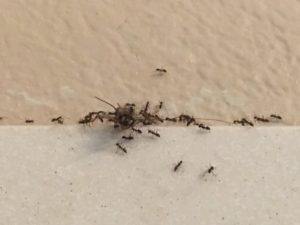
Come in all shapes and sizes, and cause many health-related problem including asthma in young children. They can transfer bacteria and disease. In Arizona, roaches can get up to 2 inches. They come from the sewers during late Spring and early Summer. They like warm, dark humid shelters and often move around the kitchen sink and the cabinets. In the warm climate of Arizona, American cockroaches often live out of doors, in alleys, lawns, decayed trees and plants.
RATS and MICE
Rats can be as long as “12-16” long, this include tail length. They are prolific breeders having 4-6 litters annually. They can damage and destroy homes by chewing on the wires, installation, and wood material. They build nests and execrate waste inside walls and attic.
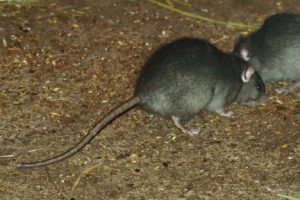
Scorpions love landscape, river rocks, palm, and mesquite trees, pool toys, or cool dark cracks. They eat insects, spiders and other scorpions. They carry their young on their backs. Scorpions are primarily nocturnal and glow when exposed to black light. Arizona is known to have dozens of species of scorpions. They can live for up to six months without food and water. They are some of the hardest pests to remove. Scorpions stings can cause extreme to moderate pain. It can be fatal to individuals that are allergic, such as the elderly and young children.
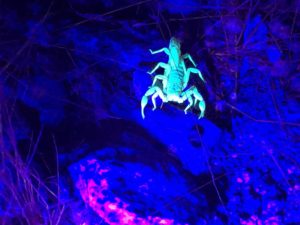
Bees are social insects. They must have a hive, and queen to survive. They are located around sugary plants, such as flowers, trees and bushes. A bee’s stinger and inflect extreme to moderate pain. If stung multiple times, it can result in hypersensitivity.

PAPER WASPS
They have paper-like honeycomb hives. They create these nests under eaves, trees and other dense shrubbery. They are very aggressive when disturbed by vibrations or loud noises. They can sting continuously, and can cause extreme to moderate pain with swelling around the sting area.
YELLOW JACKETS
They are yellow and black with stripes. They create their nest in the ground with a small hole protruding out. They will build in a wall cavity, doorway or small cracks in stucco or block. They can sting continuously and can cause extreme to moderate pain. The sting can cause irritation on the skin. They will defend their nest if disturbed. They have a pheromone that they will release to signal an attack to others in the nest.
MUD DAUBERS
They do not sting. They create mud tubes on the side of houses, trees or other solid structures. The tubes are created by mud and saliva.
They are a more of a nuisance. They have a distinctive chirping, mainly at night. They chew on just about anything from carpets to cloths. They prefer warm dry conditions.
Earwigs are harmless. They love gardens and are more of a pest.
The female has the hour glass shape on its underside. It will bite and the venom is toxic to humans. The bite can cause severe allergic reactions. If bitten, go to the doctor as soon as possible. The bites are painful and can cause a rise in body temperature and blood pressure as well as nausea and sweating.
BROWN RECLUSE
Their bites can kill a human. The recluse’s venom will cause the skin to turn black. If bitten, go to the emergency room immediately. Brown Recluse bites can become infected and cause extreme to moderate pain. If untreated, the open wound can cause skin tissue to die. They eat soft shell insects and hunt at night. They keep their food in a spin web. They like dark, quiet locations.
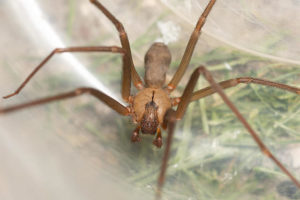
HOUSE SPIDER
They have a round abdomen with dark markings and have silky webs to catch their prey. They create their webs at random. If they do not catch a prey, they abandon the web and move to the next location.
WOLF SPIDER
They are large, fast, brown and hairy. The wolf spiders hunt their prey by running and catching them. They do not typically have webs. They like a dry climate with light and warmth. If found in a home, they will stay around windows, doors, ceilings, and house plants.
GOPHERS
Gophers like to build complex underground tunnels. You can normally follow their paths with the mounds of dirt that they push up. Gophers are solitary animals. You will only find one gopher per tunnel. They like to eat the roots of the plants in the soil.
Resolution – Trap, bait, blasting and flooding the tunnel
SKUNKS
Skunks are attracted to residents by the food/garbage that is left behind. They like low lying structures. They will also make a home in a hole or in the crawl space of a home. They will also dig holes in grass and gardens.
Resolution – Remove the food source, trapping, fencing, and cover up holes.
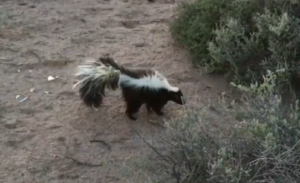
PIGEONS
A pigeon will build a nest where ever it can. It loves small places like an eve of a home, or a small opening in a commercial building. Once they find a place to nest or to roast, they will continue to come back until they are either trapped or pushed out of the area. They are very dirty birds. They will feces anywhere and everywhere. They are a carrier all types of diseases such as salmonella, cryptococcosis, and toxoplasmosis. Their droppings will destroy roofs, the side of a home and ever commercial buildings.
Resolution – Removed feed, put screens in the voids, trapping, and exterminating
Accepted payment methods:
![]()
![]()
![]()
![]()
Schedule a Consultation Today
Call 480-229-6799 or
Click HereRuby’s Pest Control provides services in Chandler, Gilbert, Mesa, Tempe, and Ahwatukee Foothills
Providing services for general pests including Ants, Earwigs, cockroach, crickets, spiders, flies, mosquitoes and scorpions, and specializing in removing (and relocating if need be) bees.



